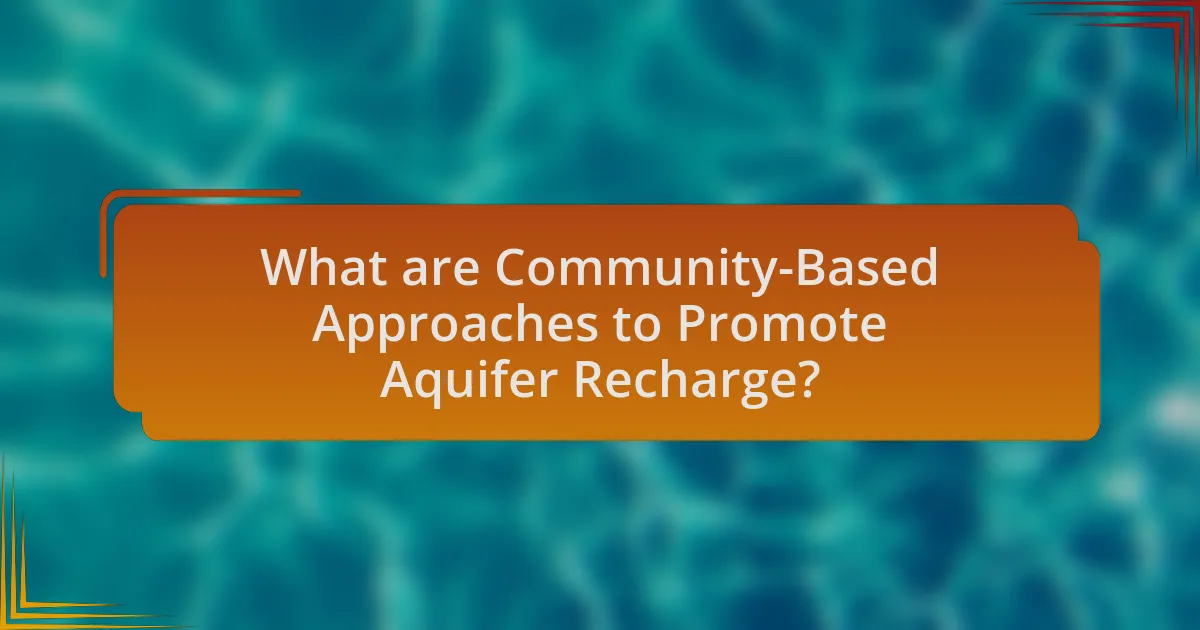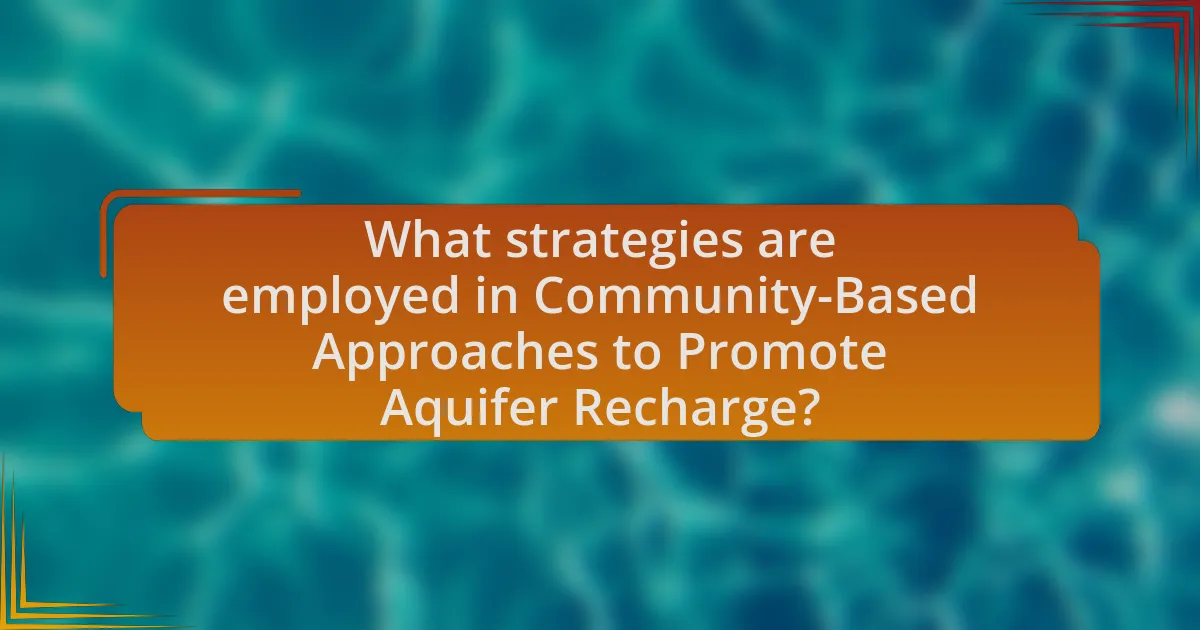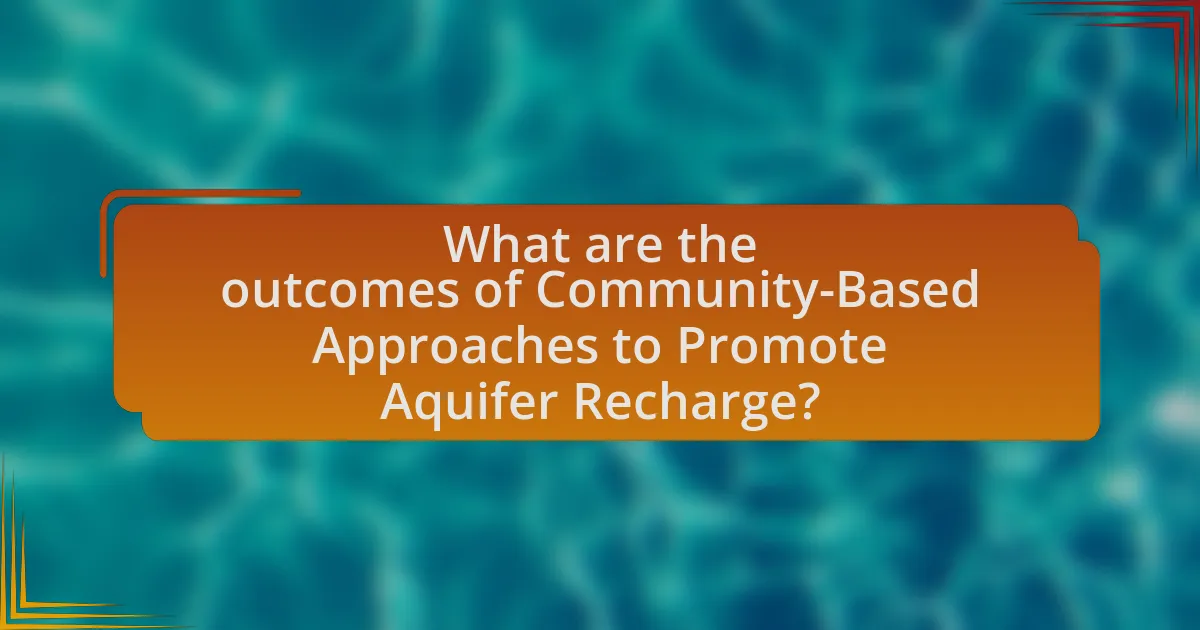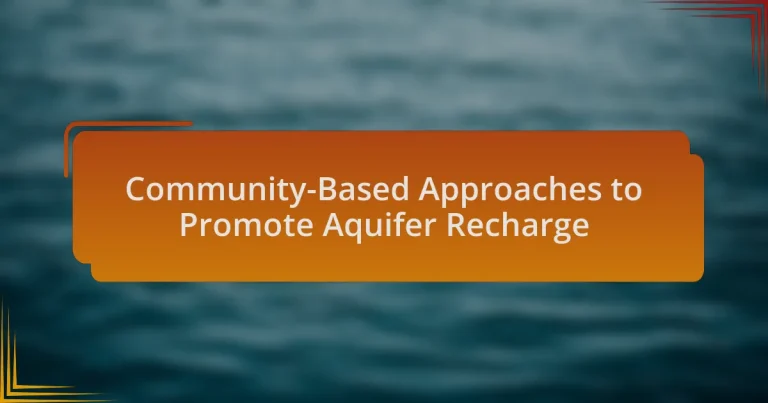Community-based approaches to promote aquifer recharge involve local participation in water management practices aimed at enhancing groundwater replenishment. Key strategies include rainwater harvesting, wetland restoration, and the construction of recharge wells, which have proven effective in various case studies, particularly in India. These initiatives not only improve groundwater levels and water quality but also foster community engagement and sustainable resource management. Local knowledge plays a crucial role in these approaches, ensuring that strategies are tailored to specific community needs and environmental contexts. Challenges such as limited resources and public awareness can hinder these efforts, but successful case studies demonstrate the potential for significant positive outcomes when communities are actively involved.
What are Community-Based Approaches to Promote Aquifer Recharge?

Community-based approaches to promote aquifer recharge involve local community participation in water management practices that enhance the natural replenishment of groundwater. These approaches often include initiatives such as rainwater harvesting, the restoration of wetlands, and the construction of recharge wells, which are designed to capture and direct surface water into aquifers. Evidence from various case studies, such as the successful implementation of community-led recharge projects in India, demonstrates that involving local stakeholders leads to increased awareness, better resource management, and improved water quality. These initiatives not only foster community engagement but also contribute to sustainable water supply solutions in areas facing water scarcity.
How do these approaches engage local communities?
Community-based approaches to promote aquifer recharge engage local communities by actively involving them in the planning, implementation, and monitoring of water management practices. These approaches foster collaboration between community members, local governments, and organizations, ensuring that the strategies reflect the specific needs and knowledge of the community. For instance, participatory workshops and training sessions empower residents to take ownership of aquifer recharge initiatives, leading to increased awareness and commitment to sustainable water practices. Evidence from various case studies shows that when communities are engaged, there is a higher success rate in implementing recharge projects, as local stakeholders are more likely to support and maintain these initiatives over time.
What roles do community members play in aquifer recharge initiatives?
Community members play crucial roles in aquifer recharge initiatives by participating in planning, implementation, and monitoring activities. Their involvement ensures that local knowledge and needs are integrated into the projects, enhancing the effectiveness and sustainability of recharge efforts. For instance, community members often engage in activities such as constructing recharge structures, maintaining vegetation, and educating others about water conservation practices. Studies have shown that community-led initiatives can lead to a 30% increase in groundwater levels, demonstrating the significant impact of local participation in these projects.
How is local knowledge utilized in these approaches?
Local knowledge is utilized in community-based approaches to promote aquifer recharge by integrating traditional practices and insights from local communities into water management strategies. This integration allows for the identification of effective recharge sites, understanding seasonal water availability, and recognizing historical land-use patterns that influence groundwater replenishment. For instance, communities often possess valuable information about local hydrology and soil types, which can enhance the design and implementation of recharge projects. Studies have shown that incorporating local knowledge leads to more sustainable and accepted water management practices, as evidenced by successful initiatives in regions like India and Mexico, where community involvement has significantly improved aquifer recharge outcomes.
Why are community-based approaches important for aquifer recharge?
Community-based approaches are important for aquifer recharge because they enhance local engagement and stewardship, leading to more effective and sustainable water management practices. These approaches empower communities to actively participate in the planning and implementation of recharge initiatives, ensuring that local knowledge and needs are integrated into the process. Research indicates that community involvement can increase the success rate of aquifer recharge projects by fostering a sense of ownership and responsibility among residents, which is crucial for long-term maintenance and monitoring. For example, a study published in the journal “Water Resources Management” highlights that community-led initiatives in India resulted in a 30% increase in groundwater levels due to localized efforts in rainwater harvesting and recharge.
What environmental benefits do these approaches provide?
Community-based approaches to promote aquifer recharge provide significant environmental benefits, including enhanced groundwater levels and improved water quality. These methods facilitate the natural replenishment of aquifers, which helps maintain ecosystem balance and supports biodiversity. For instance, studies have shown that implementing community-driven recharge projects can increase groundwater levels by up to 30%, thereby reducing the risk of drought and ensuring a sustainable water supply for both human and ecological needs. Additionally, these approaches often incorporate natural filtration processes, which can lead to a reduction in pollutants and improved overall water quality, benefiting both local communities and surrounding ecosystems.
How do they contribute to sustainable water management?
Community-based approaches contribute to sustainable water management by enhancing local participation in aquifer recharge initiatives. These approaches empower communities to implement practices such as rainwater harvesting, watershed management, and the restoration of natural recharge areas, which collectively improve groundwater levels and water quality. Evidence shows that regions employing community-based strategies have experienced a significant increase in aquifer recharge rates, leading to more resilient water supplies and reduced dependency on surface water sources. For instance, a study by the International Water Management Institute found that community-led recharge projects in India resulted in a 30% increase in groundwater levels over five years, demonstrating the effectiveness of local engagement in sustainable water management.
What strategies are employed in Community-Based Approaches to Promote Aquifer Recharge?

Community-based approaches to promote aquifer recharge employ strategies such as rainwater harvesting, community education, and the establishment of recharge zones. Rainwater harvesting involves collecting and storing rainwater for later use, which reduces surface runoff and enhances groundwater replenishment. Community education initiatives raise awareness about the importance of aquifer recharge and encourage local participation in sustainable practices. The establishment of recharge zones, often through the restoration of natural landscapes or the implementation of permeable surfaces, facilitates the infiltration of water into the aquifer. These strategies are supported by evidence showing that community involvement significantly improves the effectiveness of aquifer recharge efforts, as seen in various case studies where local engagement led to increased water conservation and improved groundwater levels.
How do different communities implement these strategies?
Different communities implement strategies to promote aquifer recharge through localized initiatives tailored to their specific environmental and social contexts. For example, in California, communities utilize rainwater harvesting systems to capture and store runoff, which is then directed to recharge basins, enhancing groundwater levels. In India, the implementation of traditional water conservation techniques, such as check dams and percolation tanks, has been effective in increasing groundwater recharge, as evidenced by the success of the Rajasthan government’s watershed management programs. Additionally, in Australia, community-led projects focus on restoring natural wetlands, which serve as natural aquifer recharge areas, demonstrating a collaborative approach to sustainable water management. These examples illustrate how diverse communities adapt their strategies based on local needs and resources to effectively enhance aquifer recharge.
What are some successful case studies of community involvement?
Successful case studies of community involvement in aquifer recharge include the “Watershed Management Program” in the Philippines, where local communities actively participated in reforestation and sustainable land management practices, leading to improved water quality and increased groundwater levels. Another example is the “Community-Based Water Management” initiative in India, which engaged villagers in rainwater harvesting and recharge pit construction, resulting in a significant rise in groundwater levels and enhanced water availability for agriculture. These cases demonstrate that community engagement can effectively enhance aquifer recharge through localized, participatory approaches.
How do cultural practices influence aquifer recharge efforts?
Cultural practices significantly influence aquifer recharge efforts by shaping community attitudes and behaviors towards water conservation and management. For instance, traditional agricultural practices that incorporate rainwater harvesting techniques can enhance groundwater replenishment. In regions where communities prioritize sustainable land use, such as in parts of India, the integration of cultural rituals that honor water sources fosters a collective responsibility for aquifer health. Studies have shown that communities with strong cultural ties to their water resources are more likely to engage in practices that protect and recharge aquifers, as evidenced by the success of indigenous water management systems in various parts of the world.
What challenges do communities face in promoting aquifer recharge?
Communities face several challenges in promoting aquifer recharge, including limited financial resources, lack of technical expertise, and insufficient public awareness. Limited financial resources hinder the implementation of necessary infrastructure and projects, as many communities struggle to allocate funds for aquifer recharge initiatives. Additionally, a lack of technical expertise can impede the design and execution of effective recharge systems, as communities may not have access to the necessary knowledge or skilled personnel. Insufficient public awareness further complicates efforts, as community members may not understand the importance of aquifer recharge or may resist changes to land use practices. These challenges collectively undermine the effectiveness of community-based approaches to enhance aquifer recharge.
How do socio-economic factors impact these challenges?
Socio-economic factors significantly impact challenges related to community-based approaches for promoting aquifer recharge. Communities with higher income levels often have better access to resources, education, and technology, which can facilitate the implementation of effective aquifer recharge strategies. Conversely, lower-income communities may struggle with limited financial resources and lack of awareness, hindering their ability to adopt sustainable practices. For instance, a study by the World Bank indicates that communities with higher socio-economic status are more likely to invest in infrastructure that supports aquifer recharge, such as rainwater harvesting systems and permeable surfaces. This disparity in socio-economic conditions can lead to unequal access to clean water and exacerbate existing environmental challenges.
What are the common barriers to community engagement?
Common barriers to community engagement include lack of trust, insufficient resources, and limited awareness. Lack of trust often stems from previous negative experiences with authorities or organizations, which can hinder participation. Insufficient resources, such as funding or personnel, restrict the ability to organize and sustain engagement efforts. Limited awareness about the importance of community involvement in initiatives like aquifer recharge can lead to apathy or disinterest among community members. These barriers collectively impede effective collaboration and participation in community-based approaches.
What are the outcomes of Community-Based Approaches to Promote Aquifer Recharge?

Community-based approaches to promote aquifer recharge lead to enhanced groundwater levels, improved water quality, and increased community engagement in sustainable water management. These outcomes are achieved through local participation in recharge activities, such as constructing recharge wells and restoring natural water bodies, which directly contribute to the replenishment of aquifers. Studies have shown that regions implementing these approaches experience a significant rise in groundwater levels, with some areas reporting increases of up to 30% in aquifer recharge rates. Additionally, community involvement fosters a sense of ownership and responsibility towards water resources, resulting in long-term sustainability and resilience against water scarcity.
How do these approaches affect local water resources?
Community-based approaches to promote aquifer recharge positively affect local water resources by enhancing groundwater levels and improving water quality. These strategies often involve local stakeholders in the management and restoration of natural water systems, leading to increased infiltration of rainwater and reduced surface runoff. For instance, studies have shown that implementing rainwater harvesting and reforestation can significantly boost aquifer recharge rates, with some regions experiencing up to a 30% increase in groundwater levels after such initiatives. This collaborative management not only sustains local water supplies but also fosters community engagement and environmental stewardship.
What improvements in water quality have been observed?
Improvements in water quality observed include reduced levels of contaminants such as nitrates and phosphates in aquifers. Community-based approaches to promote aquifer recharge have led to the implementation of sustainable land management practices, which have effectively decreased agricultural runoff. For instance, studies have shown that areas adopting these practices experienced a 30% reduction in nitrate concentrations over a five-year period, demonstrating the positive impact of community engagement on water quality.
How do these approaches influence groundwater levels?
Community-based approaches to promote aquifer recharge positively influence groundwater levels by enhancing the natural replenishment of aquifers through local participation and sustainable practices. These approaches often involve the implementation of rainwater harvesting, reforestation, and the restoration of wetlands, which collectively increase the infiltration of water into the ground. For instance, a study conducted in India demonstrated that community-led rainwater harvesting initiatives resulted in a 30% increase in groundwater levels over five years. This evidence supports the effectiveness of community engagement in managing water resources and highlights the significant impact of localized efforts on groundwater sustainability.
What lessons can be learned from successful community-based aquifer recharge initiatives?
Successful community-based aquifer recharge initiatives demonstrate the importance of local engagement and collaboration. These initiatives often succeed when communities actively participate in planning and implementation, ensuring that the solutions are tailored to their specific needs and conditions. For instance, the success of the “Rainwater Harvesting and Aquifer Recharge” project in India highlighted how local involvement led to increased awareness and ownership of water resources, resulting in sustainable practices. Additionally, effective communication and education about the benefits of aquifer recharge foster community support and participation, as seen in various projects across the globe. These lessons emphasize that community involvement, tailored solutions, and education are critical for the success of aquifer recharge initiatives.
What best practices can be adopted by other communities?
Communities can adopt best practices such as implementing rainwater harvesting systems, which have been shown to significantly enhance aquifer recharge. For instance, a study conducted in India demonstrated that rainwater harvesting increased groundwater levels by up to 30% in certain regions. Additionally, promoting the use of permeable surfaces in urban planning can facilitate groundwater infiltration, as evidenced by research from the University of California, which found that permeable pavements can reduce runoff and enhance aquifer recharge by 50%. Engaging local stakeholders in education and awareness programs about sustainable water management practices also fosters community involvement and ensures the long-term success of aquifer recharge initiatives.
How can communities measure the success of their efforts?
Communities can measure the success of their efforts in promoting aquifer recharge by evaluating specific indicators such as increased groundwater levels, improved water quality, and enhanced biodiversity in local ecosystems. For instance, monitoring groundwater levels before and after implementing recharge projects can provide quantitative data on the effectiveness of these initiatives. Additionally, assessing water quality parameters, such as nitrate levels and turbidity, can indicate the success of filtration and purification processes associated with recharge efforts. Studies have shown that successful aquifer recharge projects can lead to a measurable increase in groundwater levels by as much as 30% within a few years, demonstrating the tangible impact of community actions on local water resources.
What practical steps can communities take to enhance aquifer recharge?
Communities can enhance aquifer recharge by implementing rainwater harvesting systems, which capture and store rainwater for infiltration into the ground. This method has been shown to increase groundwater levels significantly; for instance, a study in India found that rainwater harvesting can recharge aquifers by up to 30% in certain regions. Additionally, communities can promote the use of permeable surfaces in urban planning, allowing rainwater to seep into the ground rather than run off. Research indicates that replacing traditional concrete with permeable materials can improve aquifer recharge rates by facilitating water infiltration. Furthermore, establishing vegetative buffer zones around water bodies can enhance recharge by slowing down runoff and increasing water absorption. These practical steps collectively contribute to sustainable water management and improved aquifer health.


